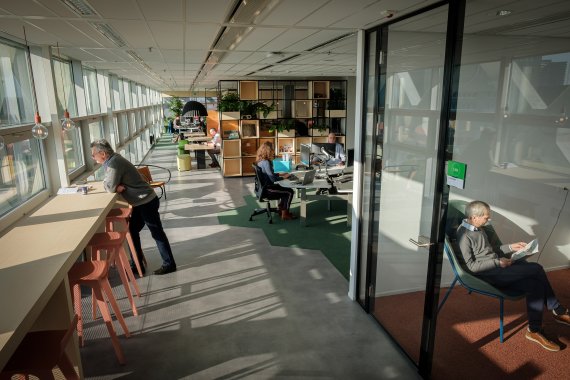Anyone can see that the campus is crowded. Just walk into a building and you’ll see staff huddled close together. The rooms are packed with desks and cupboards. Chair groups have nowhere to put their thesis-writing students. It is not always easy to find somewhere to concentrate and work quietly. And it is not getting any better because WUR is growing apace. Calculations show a need for at least a further 15,000 square metres of ‘functionally useful floor surface’ – i.e. workspace – in the offices until 2025. MyWURspace is intended to largely solve this space shortage.
What is the essence of myWURspace?
‘The intention of myWURspace is to provide the space to do your work as pleasantly and as well as possible. Space in the physical sense of the word, but also headspace. Work is changing. Collaboration is increasingly important. Collaboration within your own circle, but also between Science Groups. New working methods such as ‘scrum’ and ‘agile working’ require appropriate spaces. Young people who come in here want different office environments. A standard office with four desks in it doesn’t work anymore.’
Young people who come in here want different office environments
Does that spell the end of a desk of your own?
‘Yes. Instead you have the run of the building. That means you don’t work at one desk all the time, but in a larger area of the building. We must find a system in which everyone can choose the kind of work environment they need at any given moment. And that even might be spread over several buildings.’
MyWURspace is being put in force centrally. Why?
‘We are doing that because we think this way of working is important throughout the organization. Of course, myWORKspace will take different forms at different locations. The buildings and the kinds of work staff do are different. But we want to get the broad lines clear as to what we mean and the direction we want to go in. And we haven’t come up with that on our own. This has been discussed with the Science Groups. We are trying to steer the process together. Anyway, not every building is suited to myWORKspace. We assume that it is possible in 70 per cent of the offices, though.’
Is refurbishing the buildings enough to gain more than 15,000 square metres of space?
No. The new building plans include two large building projects: a new research building with both laboratories and office space. And a renovation and extension to Radix, both the middle and the eastern part. How much they need to expand depends on the myWURspace solutions. In three or four years’ time we shall have an idea how big that extension needs to be.’
Does myWURspace conform to the norm of 8.5 square metres of workspace per fulltime employee?
‘That norm is a way of calculating the size of offices needed. But that does not mean that everyone has an office of 8.5 square metres. The point is how you organize the space and create the physical environment that enables people to work comfortably. That is the objective, and not creating a certain number of square metres per person.’
Polls show that flexible offices are not popular. People are attached to their own spots. What does myWURspace have to offer those people?
‘At present, flexible offices are just offices with seven desks in them where there should be three. The experience is then that a flexible spot doesn’t work. As a solution to growth, more desks are often crammed into the same space. They are not nice places to work; they are too crowded. Studies show that the desks are in use for an average of 41 per cent of the time. Meeting rooms are used for 22 per cent of the time. So we need to make much smarter use of them. MyWURspace is about how you work together and how you provide the appropriate space for that.’
How are you going to implement this?
MyWURspace has already been introduced at WEcR (Wageningen Economic Research, ed.) in The Hague and on the fourth floor of Atlas. People like working there. The occupation level and people’s experience of the work environment are positive. That is what we have got to show people, by organizing visits for example. We must make sure people see and hear that this way of working increases people’s job satisfaction, and the effectiveness and impact of the organization. If we manage that, then we’ll all be on the same page.’
| Unused desks |
|---|
| Although people experience crowded working condition, work stations often go unused. A study last year showed that desks are not used for an average of 56 to 64 per cent of the time, depending where you are in the organization. Meeting rooms are used even less: 22 per cent of the time. Staff work for an average of 68 per cent of the time in the office, 10 per cent in the lab, and over 5 per cent at home, and they spend 11 per cent of their time elsewhere on the campus or in transit. |

 MyWURspace on the fourth floor of Atlas. Photo: Guy Ackermans
MyWURspace on the fourth floor of Atlas. Photo: Guy Ackermans